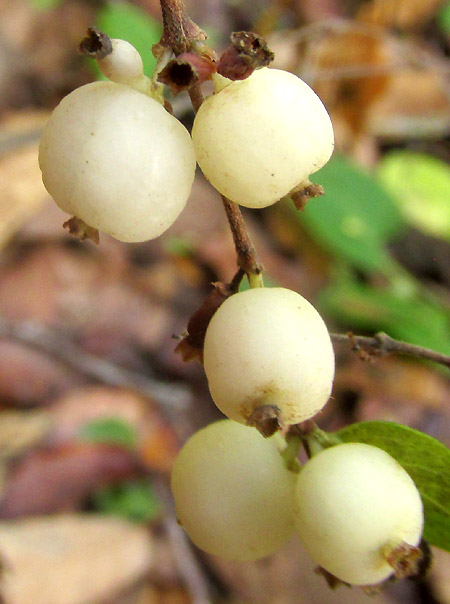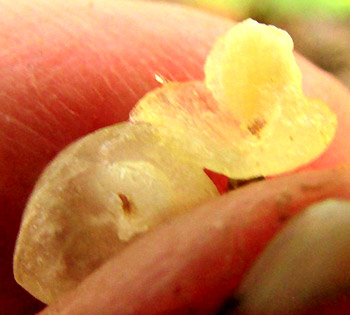Excerpts from Jim Conrad's
Naturalist Newsletter
Entry dated November 10, 2023, from notes taken on ridge with secondary oak forest about 300m west of Cascadas de La Piedad waterfall 3kms NW of the community of San Pablo, municipality of Almeaco de Bonfil; N20.1002°, W100.0067°, elevation 2360 meters (7750ft); extreme southern Querétaro state, MÉXICO
SNOWBERRY

The above shrub grew on a steep slope of a degraded oak forest. In the woods of Kentucky I'd grown up seeing such low-growing shrubs with small, simple, oval leaves arising in pairs opposite one another on slender, woody, stiff stems. Those shrubs, which we called Coralberries, also produced scattered, small, spherical fruits, but those had been purple-red, and not quite as large as these white ones. Coralberries belonged to the genus Symphoricarpos, so here was another species. Symphoricarpos belongs to the Honeysuckle Family, the Caprifoliaceae.

Up close, each fruit bore at its top a crown-like, brown, withered calyx, so each fruit had developed from a flower's inferior ovary -- meaning that the calyx, corolla and stamens had arisen atop the ovary, not at its base as with superior ovaries. Inferior ovaries are right for the Honeysuckle Family. At the top of the above picture, a small fruit is seen developing, and beside it appears to be an aborted, smaller fruit turning dark and drying up.

Above, that's a typical Symphoricarpos slender, woody, stiff and brittle stem.
The Honeysuckle Family occurs nearly worldwide, except in tropical and southern Africa; its centers of diversity are North America and eastern Asia. Currently Kew's Plant's of the World Online database accepts 33 genera, though the family's boundaries are unclear. In our Bajío region of upland central Mexico, three genera of the family are documented. Of those three, if fruits are spherical and leaves normally less than 2cm long (0.8inch), that confirms that you have a Symphoricarpos. In our area, the only Symphoricarpos present is SYMPHORICARPOS MICROPHYLLUS.
Symphoricarpos microphyllus is widespread from Honduras throughout most of upland Mexico, and into the US state of New Mexico. In English its most commonly used name is Pink Snowberry, and it's true that despite our fruits' whiteness, the literature describes fruit color as ranging from white to reddish. Their habitat is exactly that of our shrub's: slopes in open forests.

Fruits of Symphoricarpos species generally are said to be toxic, though the poisonous saponins in them aren't readily digested by humans, so they're not much of threat. Still they're considered inedible for humans. At the right, a cut-open fruit shows one of two seeds, so this is a drupe-type fruit. The flesh looks juicy, but it's a little spongy. As a kid I ate fruits of our Kentucky species, but in small quantities, and never noticed any bad effects.
The 2008 study by A.I. Quintero Sánchez and others entitled "Propagación Vegetativa de la Vara de Perlilla (Symphoricarpos microphyhllus H.B.K.)," tells us that our bush is amply used for making Christmas crafts, and brooms; this results in the natural populations being reduced. An undated, anonymously authored online Mexican government (SEMARNAT) pamphlet entitled "Manual que establece las Criterios Técnicos para el Aprovechamiento Sustentable de Recursos Forestales no Maderables de Clima Templado-Frío," further says that not only do people make their own brooms from the species, but also they sell them to intermediaries who distribute them to larger markets. The government is encouraging growing the species in plantations, where 4800 individual plants can be grown per hectare (1944 per acre).
The above study also mentions that traditionally the leaves have been chewed to cure mouth infections, or else to brush the mouth with, the fruits apparently being mashed and mixed with baking soda.
Gardeners sometimes plant Symphoricarpos microphyhllus as a small foliage plant. The species has contributed its genes to various horticulturally developed ornamental garden plants, such as the hybrid Chenault Coralberry developed in France in 1912.